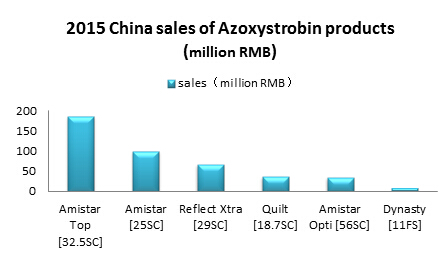As a star product with sales of 1 billion, Azoxystrobin has been rapidly growing since 2010 in China. The capacity of Azoxystrobin TC has risen to about 7000 tons with 73 registered Azoxystrobin TC and 347 Azoxystrobin formulation. Compared with Amistar of Syngenta, Chinese enterprises have released Azoxystrobin brand products, such as Nongjingling(48% difenoconazole Azoxystrobin SC ) from Huizhou City Silver agricultural science and Technology Co., Ltd., Dingmiao (30% difenoconazole Azoxystrobin SC) from Shenzhen Noposion Agrochemicals Co., Ltd, and Hemei (250g/L Azoxystrobin SC ) etc. , but the Chinese azoxystrobin market development is not better than that of Syngenta.

The Production and Market Report of Azoxystrobin Charpter 1 Review 3.2.2 The Production and Sales of Azoxystrobin in China
Charpter 2 Production Processes of Azoxystrobin
2.1 Systhetic Processes of Azoxystrobin
2.2 The Preparation Method of Main Intermediate
2.2.1 The Preparation Method of 2- (2- hydroxy phenyl) -3- methoxy methyl acrylate 2.2.2 The Preparation Method of 4,6-Dichloropyrimidine
2.2.3 The Systhetic Process of 2-hydroxy-benzonitril
2.3 The Current Situation of "Three Wastes" Treatment
2.3.1 The Treatment of Water Waste
2.3.2 The Treatment of Gas Waste and Solid Waste
Charpter 3 Market Profile of Azoxystrobin
3.1 Introduction on Overseas Production of Azoxystrobin
3.2 Introduction on Production of Azoxystrobin in China
3.2.1 The Distribution of Manufacturers Capacity in China
3.3 The Registration Situation of Azoxystrobin in China
Charpter 4 Export Analysis of Azoxystrobin
4.1 Export Situation of Azoxystrobin
4.2 Export Situation of Azoxystrobin TC
Charpter 5The Industry Chain of Azoxystrobin
Charpter 6The Development Trend and Investment Risk
6.1 The Demand and Price Trend
6.2 The Trend of Major production technology
6.3 The Change of Competition Pattern